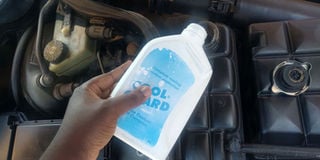Tips to care for your radiator

Coolant being added to a reservoir from which it flows to the radiator. PHOTO BY MARK KAWALYA
What you need to know:
- It is important for any driver to notice that overheating is one of the major causes of engine failure, especially in diesel vehicles and this is exactly why a proper working radiator is a must.
- Deo Lutwama, a mechanic, says coolant also protects the metal components in the engine and prevents rust buildup. Rusting would occur if the engine is running cooled by water.
Phillip drives a Toyota Caldina that he has owned for six years. The car runs just fine although he confesses that he cannot drive it upcountry.
This is because his radiator fluid leaks, necessitating him to add water each morning. Without adding water, he says, the engine would not be able to have any fluid during his morning and evening drive to and from work.
A faulty radiator is not able to properly cool the engine and this can lead to expensive engine damage. Like many parts of a vehicle, there are things you can do to ensure that the overall health of your radiator is maintained.
Coolant
Resist the temptation to fill up your radiator with water instead of coolant as a money-saving gimmick. Coolant is specifically formulated to transfer heat and prevent engine damage caused by boiling.
Deo Lutwama, a mechanic, says coolant also protects the metal components in the engine and prevents rust buildup. Rusting would occur if the engine is running cooled by water.
Coolant needs to be replaced after about 50,000km as it decomposes and its efficacy is lost. Only use coolant from an approved fuel station. There are some unscrupulous dealers selling coolant that is not approved, which may not be able to protect your engine.
Cleaning
A radiator has external fins, which look like a network of fine wire patterns. These channel cool air from the front of the car and send it towards the radiator. The fins get blocked over time by insects, soil particles and leaves, which hamper the flow of air. Ultimately this can lead overheating, as the radiator will not be working, as it should.
Have a mechanic remove your radiator and clean the fins with a water hose and a soft brush. The fins are easily deformed so they need to be cleaned gently. After the debris has been removed from the fins, they should be rinsed out with water to clear out finer particles that may remain.
Engine bay inspection
Open your car’s bonnet and with a flashlight inspect the radiator for any leaks when the engine is still hot. You should not under any circumstances open the radiator cap as you will be scalded by hot radiator fluid.
Lutwama adds that inspecting your radiator while the engine is hot enables you to see if any coolant is escaping due to the pressure buildup of the hot engine. If the plastic tops of your radiator are compromised, you will see coolant leaking through cracks.
You can have a leaky radiator top replaced at about Shs150,000. Lutwama cautions against having a mechanic plug the holes with epoxy because heat forces the epoxy to fail. Also, inspect your engine hoses to ensure they are liquid-tight and are not leaking.
Flush the radiator
This process involves removing all the old coolant from your radiator and it should be done every two years. After the coolant has been removed, fill the radiator with water and run the engine for about 15 minutes to clean the internal components. Wait for the engine to cool then drain the water and replace it with coolant.
One of the ways to tell if your car needs a radiator flush is when you notice a change in the colour of your coolant over time.
Lutwama says flushing the radiator helps remove deposits and particles that if not addressed can lead to engine problems. A flush will also introduce new coolant in your radiator, which lubricates moving parts of the systems such as the water pump extending their life spans.
Monitor temperature
Every car has a heat gauge that indicates the working temperature of the engine. It is prudent to periodically check this gauge as it can prevent your engine from overheating. If it shows that the temperature is abnormally high, it could be a sign that something about your radiator is not working, as it should.
It could also be a result of coolant loss meaning your engine is not being cooled, as it should. Drive to the nearest fuel station and have a technician inspect the radiator for you. If the temperature is high, then stop the car and wait for it to cool before inspecting if there is sufficient coolant in your radiator.
Other checks to perform
Ensure your thermostat is working well and is regulating the coolant flow. It is a common practice for mechanics here to remove thermostats claiming your car does not need it in our climate. This is a misguided practice as your car’s thermostat was included in the car for a reason.
Also, make sure your radiator cap is functional and prevents pressure loss. There is no excuse for driving a car with a faulty radiator cap as some of them cost as low as Shs15,000.




